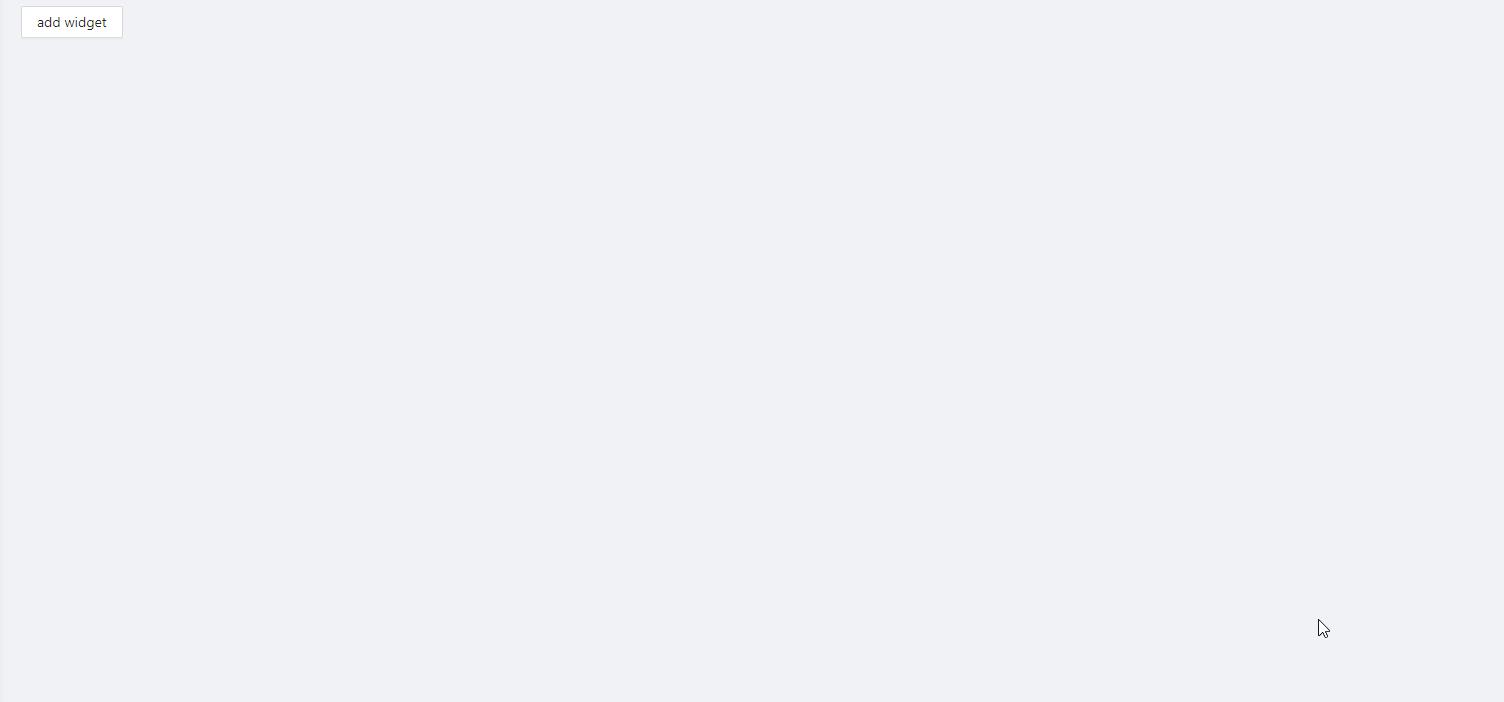使用react-grid-layout和echarts-for-react实现一个支持拖拽的自定义响应式dashboard页面
Posted c.
tags:
篇首语:本文由小常识网(cha138.com)小编为大家整理,主要介绍了使用react-grid-layout和echarts-for-react实现一个支持拖拽的自定义响应式dashboard页面相关的知识,希望对你有一定的参考价值。
文章目录
使用react-grid-layout和echarts-for-react实现一个支持拖拽的自定义响应式dashboard页面
需求概要
在前端工作中,我们会经常遇到自定义dashboard页这样的需求。然后我想做一个能够让用户可以在面板上自由的拖拽,固定(不允许拖拽),拖拉改变大小、新增,删除组件。组件可以是各种echarts图形,也可是各种数据表格。通过各个组件的拖拽组合,从而让用户自定义需要的dashboard页。
我们直接先来看最终的效果

技术栈
那我们这里就会是用到react-grid-layout和echarts-for-react
首先echarts-for-react,顾名思义就是用来绘制echarts图表的,这里不过多解释。然后react-grid-layout 是一个网格布局系统,可以实现响应式的网格布局,并且支持分割点(breakpoints)的设置,灵活运用可以方便的实现拖拽式组件的实现。
具体使用就不多介绍了,可以直接去官网看看,例子很多也很详细:https://github.com/react-grid-layout/react-grid-layout
简单实现
下面是dashboard的主渲染入口
import React, useState from "react";
import 'react-grid-layout/css/styles.css'
import 'react-resizable/css/styles.css'
import Layout, Responsive, WidthProvider from "react-grid-layout";
import Button from "antd";
import findIndex from "lodash";
import './dashboard.css'
import WidgetLoadingSpin from "@/pages/Dashboard/Detail/WidgetLoadingSpin";
import CloseOutlined, LockOutlined, QuestionCircleOutlined, UnlockOutlined from "@ant-design/icons";
const BarChartWidgetLazy = React.lazy(() => import('@/pages/Dashboard/Detail/Widget/BarChartWidget'));
const PieChartWidgetLazy = React.lazy(() => import('@/pages/Dashboard/Detail/Widget/PieChartWidget'));
const ResponsiveReactGridLayout = WidthProvider(Responsive);
interface DashboardWidgetInfo
widgetName: string,
layout: Layout
function DashboardGird()
const [widgets, setWidgets] = useState<DashboardWidgetInfo[]>([]);
const [currentCols, setCurrentCols] = useState<number>(12);
const getLayouts: any = () =>
return widgets.map(item => item.layout);
const setLayoutStatic = (widget: DashboardWidgetInfo, staticFlag: boolean) =>
const index = findIndex(widgets, (w: any) => w.widgetName === widget.widgetName);
if (index !== -1)
const updateWidget = widgets[index];
updateWidget.layout.static = staticFlag;
widgets.splice(index, 1, ...updateWidget);
const newWidgets = [...widgets];
setWidgets(newWidgets);
const lockWidget = (widget: DashboardWidgetInfo) =>
setLayoutStatic(widget, true);
const unlockWidget = (widget: DashboardWidgetInfo) =>
setLayoutStatic(widget, false);
const onRemoveWidget = (widget: DashboardWidgetInfo) =>
const widgetIndex = findIndex(widgets, (w: any) => w.layout.i === widget.layout.i);
if (widgetIndex !== -1)
widgets.splice(widgetIndex, 1);
const newWidgets = [...widgets];
setWidgets(newWidgets);
const getWidgetComponent = (widgetName: string) =>
if (widgetName === 'PieChartWidget') //可以改成策略
return (<React.Suspense fallback=<WidgetLoadingSpin/>>
<PieChartWidgetLazy/>
</React.Suspense>);
else
return (<React.Suspense fallback=<WidgetLoadingSpin/>>
<BarChartWidgetLazy/>
</React.Suspense>);
const createWidget = (widget: DashboardWidgetInfo) =>
return (
<div className='dashboard-widget-wrapper' key=widget.layout.i data-grid=widget.layout>
<span className='dashboard-widget-header'>
<QuestionCircleOutlined className='dashboard-widget-header-icon'/>
widget.layout.static ? <LockOutlined className='dashboard-widget-header-icon' onClick=() => unlockWidget(widget)/> : (
<UnlockOutlined className='dashboard-widget-header-icon' onClick=() => lockWidget(widget)/>)
<CloseOutlined className='dashboard-widget-header-icon' onClick=() => onRemoveWidget(widget)/>
</span>
getWidgetComponent(widget.widgetName)
</div>
);
const onAddWidget = () =>
const x = (widgets.length * 3) % (currentCols);
const widgetName = x % 2 == 0 ? 'BarChartWidget' : 'PieChartWidget'
const newWidgets = [...widgets,
widgetName: widgetName,
layout: i: widgetName, x: x, y: Infinity, w: 3, h: 2, static: false
] as DashboardWidgetInfo[];
setWidgets(newWidgets);
const onBreakpointChange = (newBreakpoint: string, newCols: number) =>
setCurrentCols(newCols);
const onLayoutChange = (layouts: any[]) =>
for (const layout of layouts)
const updateIndex = findIndex(widgets, (w) => w.layout.i === layout.i);
if (updateIndex !== -1)
const updateWidget = widgets[updateIndex];
updateWidget.layout = layout;
widgets.splice(updateIndex, 1, ...updateWidget);
const newWidgets = [...widgets];
setWidgets(newWidgets);
return (
<>
<Button onClick=onAddWidget>add widget</Button>
<ResponsiveReactGridLayout
layouts=getLayouts()
className='layouts'
onLayoutChange=onLayoutChange
onBreakpointChange=onBreakpointChange>
widgets?.map(item => createWidget(item))
</ResponsiveReactGridLayout>
</>
);
export default DashboardGird
然后接下来是自己的一些自定制化的一些图表或者表格的组件
import React from "react";
import WidgetLoadingSpin from "@/pages/Dashboard/Detail/WidgetLoadingSpin";
const ReactEchartsLazy = React.lazy(() => import('echarts-for-react'));
function PieChartWidget()
const getPieChart = () =>
return
color: ['#3AA1FF', '#36CBCB', '#4ECB73', '#FBD338'],
tooltip:
trigger: 'item',
formatter: 'a <br/>b: c (d%)'
,
grid:
left: '3%',
right: '4%',
bottom: '3%',
containLabel: true
,
series: [
name: '消费能力',
type: 'pie',
radius: ['40%', '55%'],
center: ['50%', '55%'],
avoidLabelOverlap: true,
itemStyle:
normal:
borderColor: '#FFFFFF',
borderWidth: 2
,
label:
normal:
show: false,
,
,
labelLine:
normal:
show: false
,
data: [
name: 'a',
value: '20'
,
name: 'b',
value: '40'
,
name: 'c',
value: '10'
,
name: 'd',
value: '10'
]
]
;
return (<React.Suspense fallback=<WidgetLoadingSpin/>>
<ReactEchartsLazy
option=getPieChart()
notMerge=true
lazyUpdate=true
style=width: '100%', height: '100%'/>
</React.Suspense>)
export default PieChartWidget
import React from "react";
import WidgetLoadingSpin from "@/pages/Dashboard/Detail/WidgetLoadingSpin";
const ReactEchartsLazy = React.lazy(() => import('echarts-for-react'));
function BarChartWidget()
const getBarChart = () =>
return
tooltip:
trigger: 'axis',
axisPointer:
type: 'shadow'
,
grid:
left: '3%',
right: '4%',
bottom: '3%',
containLabel: true
,
xAxis: [
type: 'category',
data: ['2014', '2015', '2016', '2017', '2018', '2019'],
axisLine:
lineStyle:
color: '#8FA3B7',//y轴颜色
,
axisLabel:
show: true,
textStyle:
color: '#6D6D6D',
,
axisTick: show: false
],
yAxis: [
type: 'value',
splitLine: show: false,
//max: 700,
splitNumber: 3,
axisTick: show: false,
axisLine:
lineStyle:
color: '#8FA3B7',//y轴颜色
,
axisLabel:
show: true,
textStyle:
color: '#6D6D6D',
,
],
series: [
name: 'a',
type: 'bar',
barWidth: '40%',
itemStyle:
normal:
color: '#FAD610'
,
stack: '信息',
data: [320, 132, 101, 134, 90, 30]
,
name: 'b',
type: 'bar',
itemStyle:
normal:
color: '#27ECCE'
,
stack: '信息',
data: [220, 182, 191, 234, 290, 230]
,
name: 'c',
type: 'bar',
itemStyle:
normal:
color: '#4DB3F5'
,
stack: '信息',
data: [150, 132, 201, 154, 90, 130]
]
;
return (
<React.Suspense fallback=<WidgetLoadingSpin/>>
<ReactEchartsLazy
option=getBarChart()
notMerge=true
lazyUpdate=true
style=width: '100%', height: '100%'/>
</React.Suspense>)
export default BarChartWidget
这里用到了React.lazy,所以还需要定制一下未加载时候渲染出来的组件
import Spin from "antd";
import React from "react";
import './dashboard.css'
function WidgetLoadingSpin()
return (
<div className='dashboard-widget-loading'><Spin tip='Loading...'/></div>
以上是关于使用react-grid-layout和echarts-for-react实现一个支持拖拽的自定义响应式dashboard页面的主要内容,如果未能解决你的问题,请参考以下文章